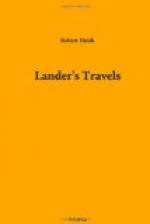CHAPTER XXVI.
The city of Eyeo, in Houssa language, Katunga, the capital of Youriba, is situated in latitude 8 deg. 59’ N., longitude 6 deg. 12 E. It is built on the sloping side and round the base of a small range of granite hills, which, as it were, forms the citadel of the town. They are formed of stupendous blocks of grey granite of the softest kind, some of which are seen hanging from the summits in the most frightful manner, while others, resting on very small bases, appear as if the least touch would send them down into the valley beneath. The soil on which the town is built is formed of clay and gravel, mixed with sand, which has obviously been produced from the crumbling granite. The appearance of these hills is that of a mass of rocks left bare by the tide. A belt of thick wood runs round the walls, which are built of clay, and about twenty feet high, and surrounded by a dry ditch. There are ten gates in the walls, which are about fifteen miles in circumference, of an oval shape, about four miles in diameter one way, and six miles the other; the south end leaning against the rocky hills, and forming an inaccessible barrier in that quarter. The king’s houses, and those of his women, occupy about a square mile, and are on the south side of the hills, having two large parks, one in front and another facing the north; they are all built of clay, and have thatched roofs, similar to those nearer the coast. The posts supporting the verandahs and the doors of the king’s or caboceer’s houses are generally carved in has relief, with figures representing the boa killing an antelope or a hog, or with processions of warriors attended by drummers. The latter are by no means meanly executed, conveying the expression and attitude of the principal man in the groupe with a lofty air, and the drummer well pleased with his own music, or rather deafening noise. There are seven different markets, which are held every evening, being generally opened about three or four o’clock. The chief articles exposed for sale are yams, corn, calavances, plantains and bananas, vegetable butter, seeds of the colocynth, which form a great article of food, sweetmeats, goats, sheep, and lambs, also cloth of the manufacture of the country, and their various instruments of agriculture. The price of a small goat is from 1,500 to 2,000 kowries; 2,000 kowries being equal to a Spanish dollar; a large sheep, 3,000 to 5,000; a cow, from 20,000 to 30,000; a horse, 80,000 to 100,000; a prime human being, as a slave, 40,000 to 60,000, about half the price of a horse!
The kingdom of Youriba extends from Puka, within five miles of the coast to about the parallel of 10 deg. N., being bounded by Dahomy on the north-west, Ketto and the Maha countries on the north, Borgoo on the north-east, the Quorra to the east, Accoura, a province of Benin, to the south-east, and Jaboo to the south-west. These are the positions of the neighbouring countries, as given by Lander, although it is difficult to reconcile them with the map; Borgoo seems rather to be north-east, Dahomy west and southwest, Jaboo and Benin south-east. If Badagry be included in Youriba, the southern boundary will be the Bight of Benin.




